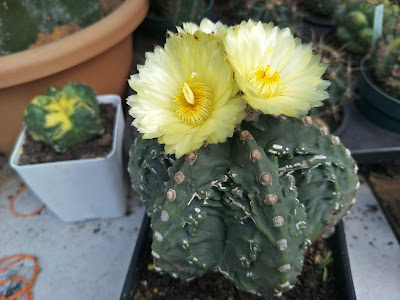How Do I Graft on Harrisia jusbertisii and Myrtillocactus geometrizans Root Stock
Step 1
Get a decent root stock, make sure they are actively growing and plump. Never used dehydrated root stock which look flaccid and soft to the touch.
Cut the top part of your root stock, it can be the top 1-2 inch up to the mid, as long as the core i.e. middle ring is still soft. best bet is to cut above the border area that has color change, for Myrtillocactus is the green (older) to green blue (younger).
Myrtillocactus and Harrisia are nice root stocks due to their thickness and ring size. Their thickness give us a better guarantee of grafting success as there is more contact between scion and root stock.
The leftover from beheading the root stock can be regrown for future use. You can see how low I cut my Myrtillocactus, I am confident in root stock length left and planning to use it in another 3-4 months from now on.
Beveling the cut edge is optional, but I always do so to prevent two complications later on. One is the risk of cut surface to dry and shrink, if it shrink then the scion will very likely fail to stick or imperfectly attach to the middle ring. Other complication is offsetting of the root stock, it it pups close to scion, it may push it up and out which usually occur anytime during both cactus lifespan.
Harrisia root stock is thicker than Myrtillocactus in my current collection, but it does not make a big difference in term of handling. Make sure you could see the ring clearly, it is crucial in getting successful graft and best growth out of the two.
Step 2
Cut your scion and make sure it is a level cut, concave cut on the scion tend to fail the graft due to shrinkage. I use Astrophytum asterias for this graft, they are around 2 to 3 cm big. Harrisia and Myrtillocactus are not that suitable for seedling grafting.
For both scion and root stock cut, make sure you do it with sterile and very sharp knife. For hard skinned cactus such as asterias, I will bevel the scion too, they tend to shrink more and push themselves upward and may fail to remain attached.
Step 3
Match their cambium ring, as long as they touch each other; the graft will work well. You can get the graft to work without any of the ring touching and attaching, but the scion will not grow at all or may grow but at a very slow pace!
See how their size match well, you can go with bigger scion but it is harder to hold them together until they fully attach, will usually take 5 to 14 days.
Step 4
Providing pressure and preventing the scion from moving are two main concern in grafting. Without pressure holding the scion, it will detach or partially detach; which may lead to scion death or may require re-grafting.
I use plastic food wrap and rubber to hold them together, some times just rubber. Harrisia root stock has thick thorns that can be use to hold the plastic, but additional rubber use reduce the risk of losing pressure.
Pull the plastic and make sure it is fittingly tight, not loose but also no too tight. you can test the scion after attaching plastic cover, if it shift to any direction; adjust the holding pressure.
Step 5
Apply rubber to hold your plastic cover in place, I use one rubber but fold it once so it stretch tighter.
Do your final adjustment if needed and left them under shade for a while. the advantage of using plastic wrap is they retain moisture from cut so they don't shrink quickly. Sometimes I forgot about my grafts, the scion just pop out of the plastic and continue growing; just make sure it is soft plastic wrap though.
I use plastic wrap to graft Leuchternbergia but in a different manner, I can't wrap it whole or they will break apart. It's all on the rubber this time, it helps holding the scion but sticking to plastic string.
Step 6
What to do with the left over? I graft my root stock onto other root stock and let them grow. They surely grow faster than on their root, you cut and root them later and in no time will be ready to be grafted too.
Hope this explanation helps.
Thanks for reading guys.
cheers.


























































